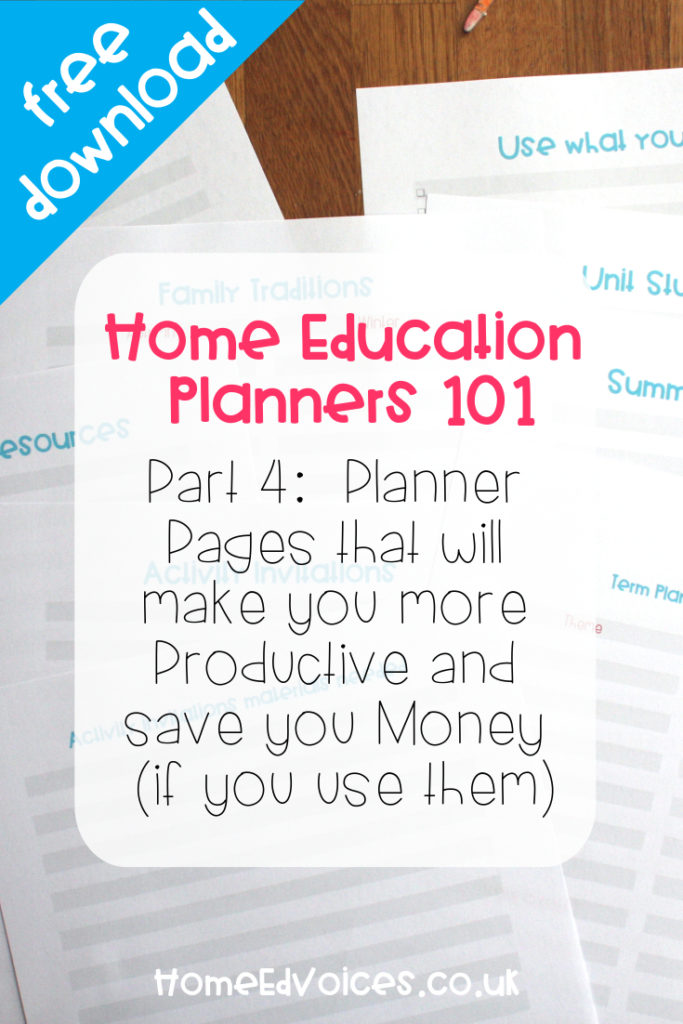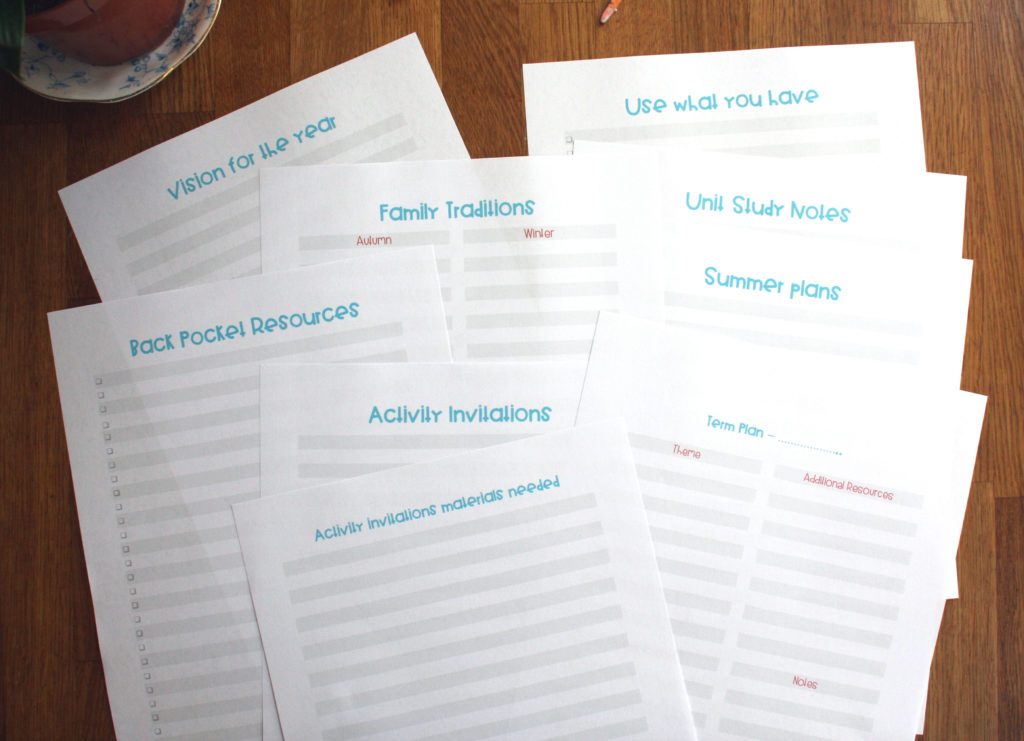Home Educations Planners 101 Pt4 – 4 Planner Pages that will make you more Productive and save you Money (if you use them)

Here are some planner pages from the Home Education Printable Planner that can save you money, and make the most of the things you have. You can download these pages to try yourself, at the bottom of the post.
(If you have a home education bullet journal you could use these pages as jumping off points to pages in your bujo, or print them out half size and stick them into your notebook.)
Bedtime Basket
A bedtime basket is the evening equivalent of a Morning Basket or Morning Time plan. It’s the idea that you might add a few things into your family’s wind down routine at the end of the day. This is particularly good for home ed parents who are nightowls, and who still have energy in an evening. But with the right plan, and a habit that makes it automatic, even early bird home ed parents (like me) can fit a few things into bedtime that you don’t get to elsewhere in the day.
Examples include:
- Mini biographies like Goodnight Stories for Rebel Girls or Stories for Boys who Dare to be different (ps. share Rebel Girls with your boys – they need to know they can have women as heroes, as well as men.)
- Picture heavy nature guides like Bones – Skeletons and How They Work
- Poem a Day books like I am the Seed that Grew the Tree
- Those interesting non fiction library books that you really want to read with your children but it doesn’t seem to happen
- Apps like Bedtime Maths
- Storytelling resources like Story Cubes or make your own story stones, (there is a great book called Show me a Story by Emily K Neuburger, that is full of make your own storytelling ideas that could be created in an afternoon and then used over and over in your bedtime basket)
Make a plan to add one or two of these things, either along side a readaloud or maybe instead of one for a week or two? Don’t make a list of 15 things. No one has the energy for that at the end of the day.
Start with one thing. Do that for a while then maybe change to something else. We did bedtime maths for 6 months then switched to a poem or two.
You could use the sheet to make the plan, or print two and use one to record the books and resources you have used.
Use What You Have
This sheet could easily have been titled ‘Know What You Have’. You don’t have to be home educating for very long before you realise that home education tends to come with stuff, and that home educators are always on the look out for useful things to try. We have good charity shops near us so I’m regularly finding books that will be usefully soon but not quiet now, and I know it’s easy to forget what you have if you’re not actually using it.
Plus it is very easy to gather digital material and then forget that you have it, because it’s not a physical item that you have to put away or that you pass on a shelf.
The Use What You Have sheet is a place to record all the useful things you have collected. That way when you need something you can look down your list to see if you have something that will work. This will save you money, and help you to avoid buying duplicates, or lots of things that cover the same information. (Ask me how I know? I decluttered 4 children’s atlases earlier this year.)
But you need to build your list.
How to Build your Use What You Have List:
I would suggest printing out a number of sheets and using one for each kind of thing you are recording – books, digital files, resources, online memberships, craft supplies, art supplies etc.
Don’t try to tackle everything at once. Work through a section at a time. Personally I would start with digital resources since you can see the physical books on your shelf, but not the ebooks tucking in a folder on your computer or in dropbox.
Add new things as you get them. Colour code things by subject, or arrange things by subject, so that you can easily see what you have.
When you see what you have, then you can stop chasing the new and start using the things you have, and following through on the big plans you had when you bought those things.
Do those things instead of researching and buy more things you won’t use either.

Activity Invitations
Activity invitations are all those things you pin on pinterest that you would like to do with your children, or – if you’re children are older – put out for your children to get stuck into.
Maybe they are art or craft projects, or STEM explorations (like building with grapes or marshmallows and toothpicks.)
This sheet gives you the place to write down a few that appeal right now, and plan out what you need and what you already have to recreate each project. Then you can gather the necessary things together, or at least list the things you need, ready for when you want to put them out for your children.
By doing the planning ahead of time, and in one go, you can avoid wasting time scrambling to look for things or the decision fatigue of scrolling through pinterest looking for ideas.
You could also use the sheet to jot down and doodle ideas and plans based on the things you put down in your Use What You Have list. That book of list prompts you wanted to work on once a week with your children, or the craft project that you thought they could make for their grandparents.
Your ideas need a home, otherwise you will forget them. If they are written down then even if you don’t get to them right away, you can come back to them.
Back Pocket Resources
Back pocket resources will probably come up on your Use What You Have sheet but it is worth giving them their own list.
They are the things that you bought on sale, or a year ago because you got a deal. Things you put in a cupboard for a rainy day, or in case you get sick and need to entertain and educate your children without using up too much energy. Things you keep in your back pocket for when you need them.
These could include:
- craft kits
- large, seasonal or education puzzles (stick on an audiobook and take some time just to soak in a long story)
- colouring books
- clay
- special or new-to-you art supplies (especially non-messy ones)
- boardgames
- card games
- dvds /digital downloads
- notebooks, cute pens and stickers
- playdough recipes
- books of paper aeroplanes or origami designs
Sometimes putting out something new and fun to do can turn a hard day around. We can make those things cheaper by buying them from charity shops, or in sales, or in discount stores and then putting them away until they are needed. But putting them away means they might get forgotten.
If you use the Back Pocket Resources sheet to record the things you have available, (and maybe where you have hidden them if you don’t have a single central place) then things won’t get lost or forgotten about, which means your money is more likely to have been well spend.
All of these sheets take effort to get the most out of them. But that work will pay you back again and again.
If you would like to try these 4 sheets out, you can get instant access to them by joining the email list.
If you are interested in purchasing the entire Home Education Printable Planner you can find it at the shop.
